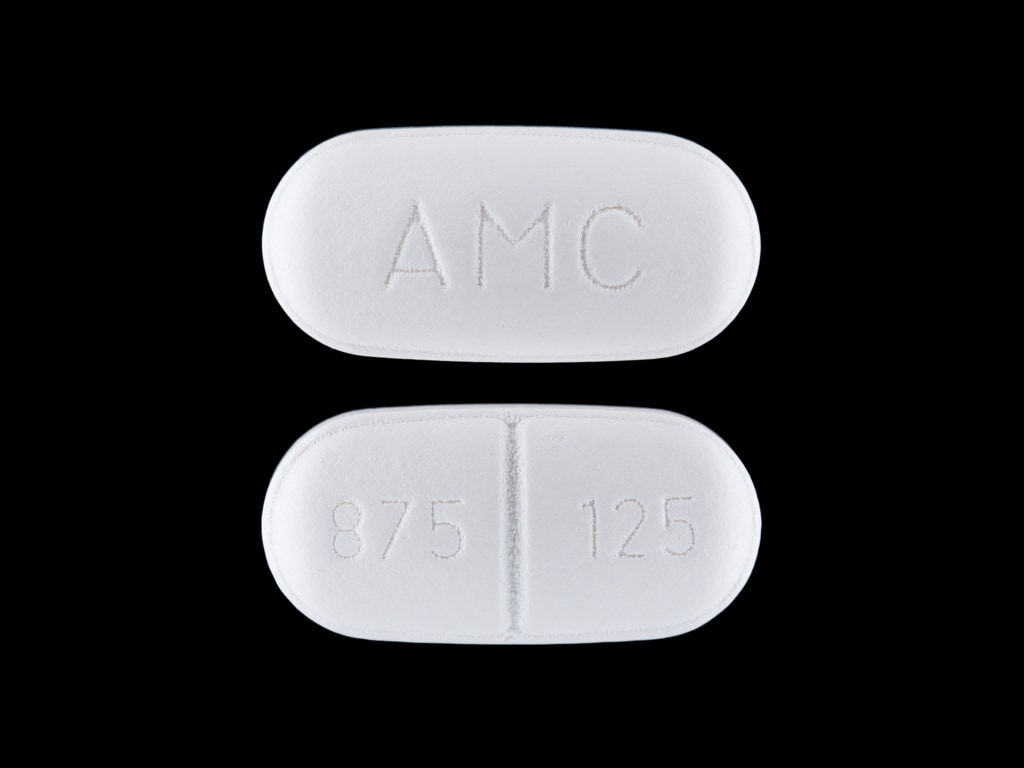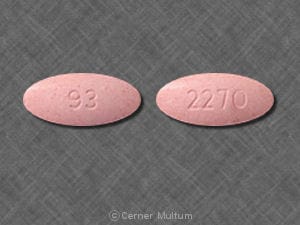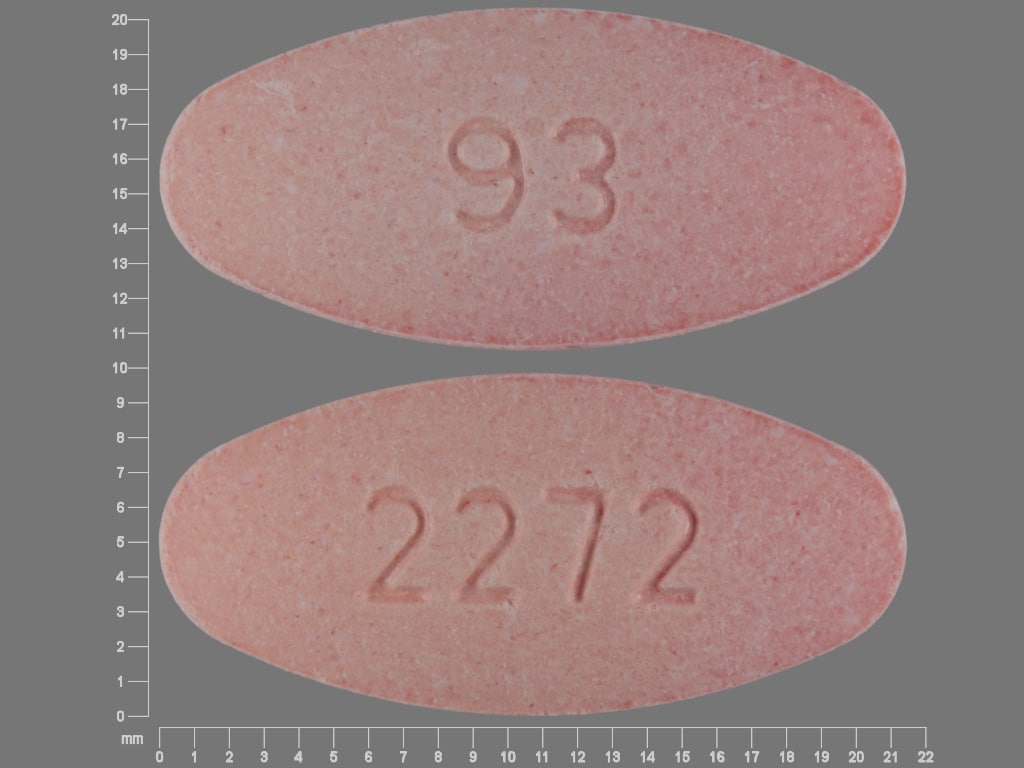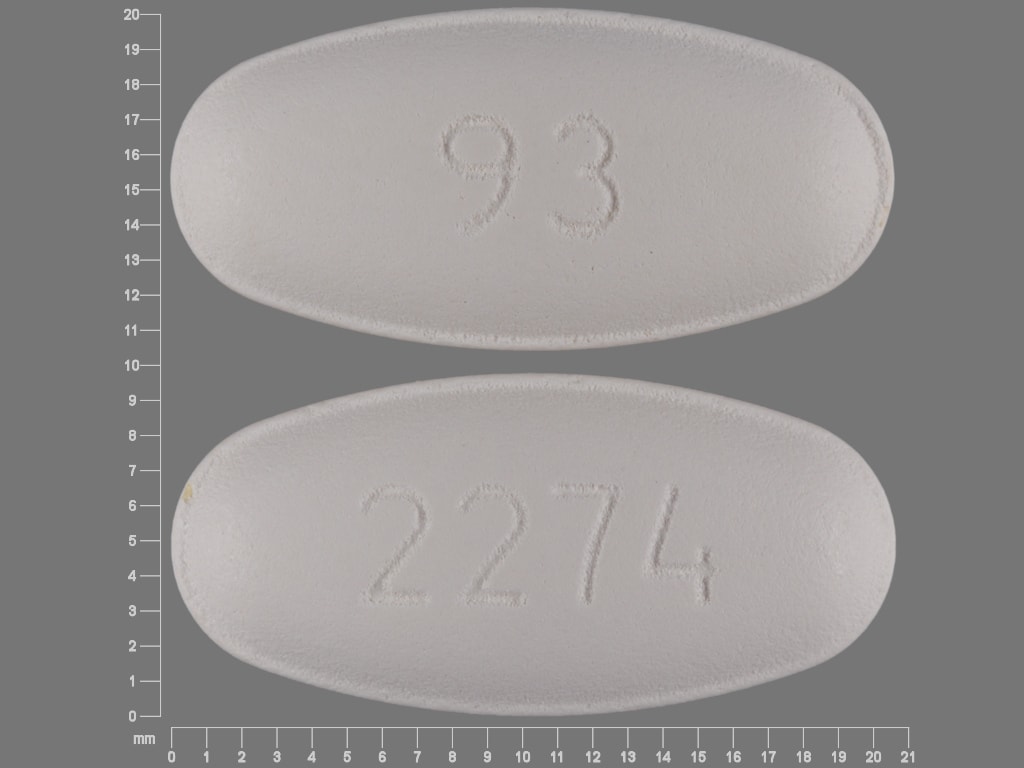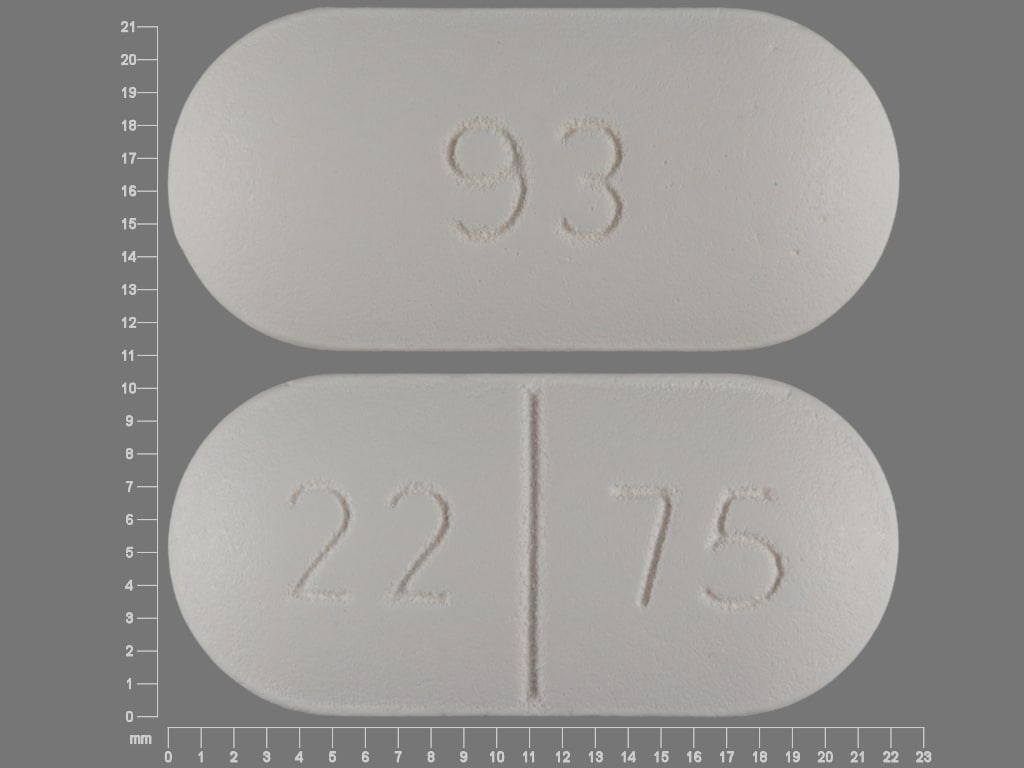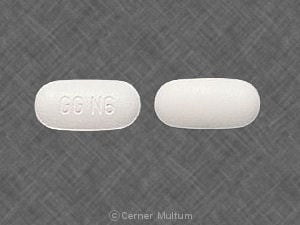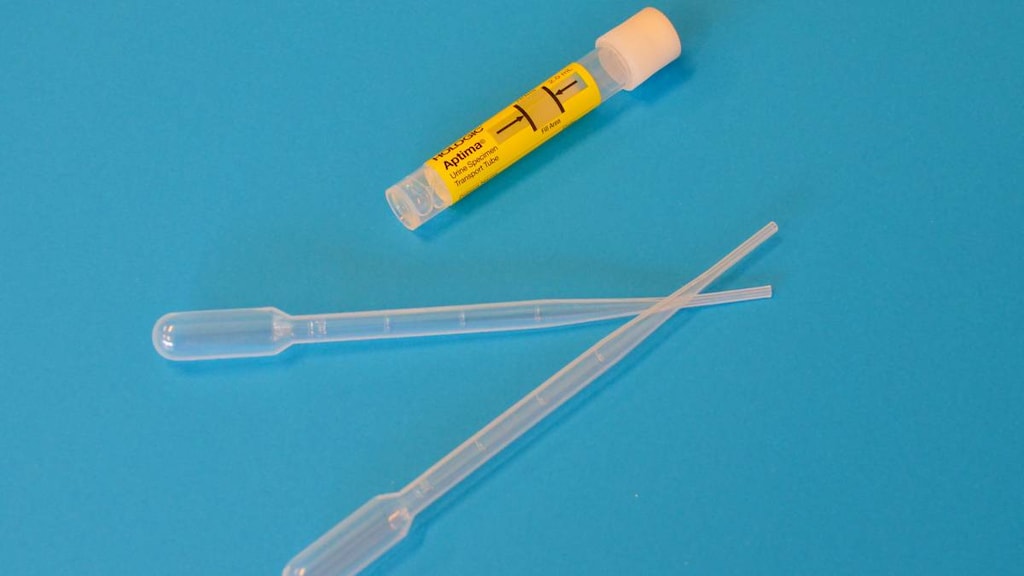Dosage Forms
Excipient information presented when available (limited, particularly for generics); consult specific product labeling. [DSC] = Discontinued product
Suspension Reconstituted, Oral:
Augmentin: Amoxicillin 125 mg and clavulanate potassium 31.25 mg per 5 mL (75 mL [DSC], 100 mL [DSC], 150 mL [DSC]) [contains aspartame, saccharin sodium; banana flavor]
Augmentin: Amoxicillin 250 mg and clavulanate potassium 62.5 mg per 5 mL (75 mL [DSC], 100 mL [DSC], 150 mL [DSC]) [contains aspartame, saccharin sodium; orange flavor]
Augmentin: Amoxicillin 250 mg and clavulanate potassium 62.5 mg per 5 mL (75 mL, 100 mL, 150 mL); Amoxicillin 125 mg and clavulanate potassium 31.25 mg per 5 mL (75 mL, 100 mL, 150 mL) [contains saccharin sodium]
Augmentin ES-600: Amoxicillin 600 mg and clavulanate potassium 42.9 mg per 5 mL (75 mL, 125 mL, 200 mL) [contains aspartame; strawberry cream flavor]
Generic: Amoxicillin 200 mg and clavulanate potassium 28.5 mg per 5 mL (50 mL, 75 mL, 100 mL); Amoxicillin 250 mg and clavulanate potassium 62.5 mg per 5 mL (75 mL, 100 mL, 150 mL); Amoxicillin 400 mg and clavulanate potassium 57 mg per 5 mL (50 mL, 75 mL, 100 mL); Amoxicillin 600 mg and clavulanate potassium 42.9 mg per 5 mL (75 mL, 125 mL, 200 mL)
Tablet, Oral:
Augmentin: Amoxicillin 500 mg and clavulanate potassium 125 mg
Augmentin: Amoxicillin 875 mg and clavulanate potassium 125 mg [DSC] [scored]
Generic: Amoxicillin 250 mg and clavulanate potassium 125 mg, Amoxicillin 500 mg and clavulanate potassium 125 mg, Amoxicillin 875 mg and clavulanate potassium 125 mg
Tablet Chewable, Oral:
Generic: Amoxicillin 200 mg and clavulanate potassium 28.5 mg, Amoxicillin 400 mg and clavulanate potassium 57 mg
Tablet Extended Release 12 Hour, Oral:
Augmentin XR: Amoxicillin 1000 mg and clavulanate potassium 62.5 mg [DSC] [scored]
Generic: Amoxicillin 1000 mg and clavulanate potassium 62.5 mg
Pharmacology
Mechanism of Action
Clavulanic acid binds and inhibits beta-lactamases that inactivate amoxicillin resulting in amoxicillin having an expanded spectrum of activity. Amoxicillin inhibits bacterial cell wall synthesis by binding to one or more of the penicillin-binding proteins (PBPs) which in turn inhibits the final transpeptidation step of peptidoglycan synthesis in bacterial cell walls, thus inhibiting cell wall biosynthesis. Bacteria eventually lyse due to ongoing activity of cell wall autolytic enzymes (autolysins and murein hydrolases) while cell wall assembly is arrested.
Pharmacokinetics/Pharmacodynamics
Excretion
Clavulanic acid: Urine (25% to 40% as unchanged drug)
Time to Peak
Clavulanic acid: Serum: 1.5 hours
Half-Life Elimination
Clavulanic acid: 1 hour
Protein Binding
Clavulanic acid: ~25%
Use: Labeled Indications
Otitis media, acute:
Immediate-release tablets, chewable tablets, oral suspension (400/57 mg per 5 mL, 250/62.5 mg per 5 mL, 200/28.5 mg per 5 mL, and 125/31.25 mg per 5 mL only): Treatment of otitis media caused by beta-lactamase-producing strains of H. influenzae and M. catarrhalis.
Oral suspension (600/42.9 mg per 5 mL concentration): Treatment of acute otitis media, recurrent or persistent, caused by S. pneumoniae (penicillin MIC = 2 mcg/mL or less), H. influenzae (including beta-lactamase-producing strains), and M. catarrhalis (including beta-lactamase-producing strains) in pediatric patients with a history of antibiotic exposure for acute otitis media in the preceding 3 months and who are either 2 years or younger or attend day care.
Pneumonia:
Extended-release tablets only: Treatment of patients with community-acquired pneumonia (CAP) caused by confirmed or suspected beta-lactamase-producing pathogens (ie, Haemophilus influenzae, Moraxella catarrhalis, Haemophilus parainfluenzae, Klebsiella pneumoniae, methicillin-susceptible Staphylococcus aureus) and Streptococcus pneumoniae with reduced susceptibility to penicillin (penicillin minimum inhibitory concentration [MIC] = 2 mcg/mL).
Limitations of use: Augmentin XR is not indicated for the treatment of infections caused by S. pneumoniae with penicillin MIC of 4 mcg/mL or greater (limited data).
Immediate-release tablets, chewable tablets, oral suspension (400/57 mg per 5 mL, 250/62.5 mg per 5 mL, 200/28.5 mg per 5 mL, and 125/31.25 mg per 5 mL only): Treatment of lower respiratory tract infection caused by beta-lactamase-producing strains of H. influenzae and M. catarrhalis.
Rhinosinusitis, acute bacterial:
Extended-release tablets: Treatment of patients with acute bacterial sinusitis caused by confirmed or suspected beta-lactamase-producing pathogens (ie, H. influenzae, M. catarrhalis, H. parainfluenzae, K. pneumoniae, methicillin-susceptible S. aureus) and S. pneumoniae with reduced susceptibility to penicillin (penicillin MIC = 2 mcg/mL).
Limitations of use: Augmentin XR is not indicated for the treatment of infections caused by S. pneumoniae with penicillin MIC of 4 mcg/mL or greater (limited data).
Immediate-release tablets, chewable tablets, oral suspension (400/57 mg per 5 mL, 250/62.5 mg per 5 mL, 200/28.5 mg per 5 mL, and 125/31.25 mg per 5 mL only): Treatment of sinusitis caused by beta-lactamase-producing strains of H. influenzae and M. catarrhalis.
Skin and skin structure infections: Immediate-release tablets, chewable tablets, oral suspension (400/57 mg per 5 mL, 250/62.5 mg per 5 mL, 200/28.5 mg per 5 mL, and 125/31.25 mg per 5 mL only): Treatment of skin and skin structure infections caused by beta-lactamase-producing strains of S. aureus, Escherichia coli, and Klebsiella spp.
Urinary tract infections: Immediate-release tablets, chewable tablets, oral suspension (400/57 mg per 5 mL, 250/62.5 mg per 5 mL, 200/28.5 mg per 5 mL, and 125/31.25 mg per 5 mL only): Treatment of urinary tract infections caused by beta-lactamase-producing strains of E. coli, Klebsiella spp, and Enterobacter spp.
Use: Off Label
Bite wound, prophylaxis or treatment (animal or human bite)yes
Based on the Infectious Diseases Society of America (IDSA) guidelines for the diagnosis and management of skin and soft tissue infections (SSTIs), amoxicillin/clavulanate is an effective and recommended treatment or prophylaxis of animal or human bite wounds.
Bronchiectasis, acute exacerbationc
Clinical experience suggests the utility of amoxicillin and clavulanate for the treatment of acute exacerbations of bronchiectasis Barker 2018, Tsang 2009.
Chronic obstructive pulmonary disease (COPD), exacerbationayes
Data from 2 randomized, double-blind studies support the use of amoxicillin and clavulanate for the treatment of bacterial exacerbations of COPD Llor 2012, Wilson 2012.
Based on the Global Initiative for Chronic Obstructive Lung Disease (GOLD) guidelines for the diagnosis, management, and prevention of COPD, amoxicillin and clavulanate is an effective and recommended treatment for COPD exacerbations GOLD 2018.
Diabetic foot infectioncyes
Data from a randomized, open-label trial suggest that amoxicillin and clavulanate may be beneficial for the treatment of diabetic foot infection Lipsky 2004.
Based on the IDSA clinical practice guideline for the diagnosis and treatment of diabetic foot infections, amoxicillin and clavulanate is an effective and recommended treatment for diabetic foot infection.
Intraabdominal infectionbyes
Data from a randomized, multicenter study support the use of amoxicillin and clavulanate for the treatment of acute uncomplicated diverticulitis Biondo 2014. Clinical experience also suggests the utility of amoxicillin and clavulanate as oral step-down therapy for the treatment of intraabdominal infection Lucasti 2008.
Based on the Surgical Infection Society (SIS)/IDSA clinical practice guideline for the diagnosis and management of complicated intraabdominal infection in adults and the SIS clinical practice guideline for the management of intraabdominal infection, amoxicillin and clavulanate is effective and recommended as oral step-down therapy for intraabdominal infection once clinically improved on parenteral therapy and patient is able to tolerate an oral diet.
Neutropenic fever, low-risk cancer patients (empiric therapy)yes
Based on the American Society of Clinical Oncology (ASCO) and Infectious Diseases Society of America (IDSA) guidelines for treatment of cancer patients with fever and neutropenia, amoxicillin and clavulanate (in combination with ciprofloxacin) is an effective and recommended oral regimen for management of low-risk patients with neutropenic fever.
Odontogenic infectionb
Data from a prospective, observational study and a prospective, randomized, single-blind study support the use of amoxicillin and clavulanate for the treatment of odontogenic infection Gerlach 1989, Tancawan 2015.
Peritonsillar cellulitis or abscessc
Data from 2 prospective, observational studies suggest the utility of amoxicillin and clavulanate for the treatment of peritonsillar abscess Lepelletier 2016, Sowerby 2013. Clinical experience also suggests the utility of amoxicillin and clavulanate for the treatment of peritonsillar cellulitis Wald 2018.
Streptococcus (group A), chronic carriageyes
Based on the IDSA clinical practice guideline for the diagnosis and management of group A streptococcal pharyngitis, amoxicillin and clavulanate is effective and recommended for eradication of group A streptococci in chronic carriers.
Contraindications
Hypersensitivity to amoxicillin, clavulanic acid, other beta-lactam antibacterial drugs (eg, penicillins, cephalosporins), or any component of the formulation; history of cholestatic jaundice or hepatic dysfunction with amoxicillin/clavulanate potassium therapy
Augmentin XR: Additional contraindications: Severe renal impairment (creatinine clearance <30 mL/minute) and hemodialysis patients
Canadian labeling: Additional contraindications (not in US labeling): Suspected or confirmed mononucleosis
Dosage and Administration
Dosing: Adult
Note: Dose is based on the amoxicillin component. Dose and frequency are product specific; not all products are interchangeable. For adults who have difficulty swallowing the tablets, the 125 mg/5 mL or 250 mg/5 mL suspension (in appropriate amounts) may be given in place of the 500 mg tablet; the 200 mg/5 mL or 400 mg/5 mL suspension (in appropriate amounts) may be given in place of the 875 mg tablet.
Usual dosing range: Oral: Immediate release: 500 mg every 8 to 12 hours or 875 mg every 12 hours; Extended release: 2 g every 12 hours
Bite wound, prophylaxis or treatment (animal or human bite) (off-label use): Oral: Immediate release: 875 mg every 12 hours (IDSA [Stevens 2014]). Note: For prophylaxis, duration is 3 to 5 days (IDSA [Stevens 2014]); for treatment of established infection, duration is typically 5 to 14 days and varies based on clinical response and patient-specific factors (Baddour 2019a; Baddour 2019b).
Chronic obstructive pulmonary disease (COPD), exacerbation (off-label use): Oral: Immediate release: 500 mg every 8 hours or 875 mg every 12 hours for 5 to 7 days (GOLD 2018; Llor 2012; Wilson 2012). Note: Some experts reserve for use in patients with complicated COPD (eg, age ≥65 years, FEV1 <50% predicted, frequent exacerbations, major comorbidities) (Anzueto 2007; Sethi 2008).
Diabetic foot infection (off-label use): Note: May be used alone for mild infections or after clinical response to parenteral therapy in patients without risk factors or concern for infection caused by Pseudomonas aeruginosa (IDSA [Lipsky 2012]; Weintrob 2018).
Oral: Immediate release: 875 mg every 12 hours (IDSA [Lipsky 2012]; Lipsky 2004; Weintrob 2018). Duration of therapy should be tailored to individual clinical circumstances; most patients with infection limited to skin and soft tissue respond to 1 to 2 weeks of therapy (IDSA [Lipsky 2012]; Weintrob 2018).
Intraabdominal infection (off-label use):
Diverticulitis, acute (for uncomplicated infection that meets criteria for outpatient therapy or as step-down therapy after clinical improvement on initial parenteral therapy): Oral:
Immediate release: 875 mg every 8 hours (Biondo 2014; Mora Lopez 2013)
Extended release: 2 g every 12 hours (Pemberton 2018)
Other intraabdominal infection, step-down therapy (when clinically improved and able to tolerate oral therapy): Oral: Immediate release: 875 mg 2 to 3 times daily (Barshak 2018; Lucasti 2008; SIS [Mazuski 2017]; SIS/IDSA [Solomkin 2010])
Duration of therapy is for 4 to 7 days following adequate source control (SIS/IDSA [Solomkin 2010]); for uncomplicated appendicitis and diverticulitis managed nonoperatively, a longer duration is necessary (Barshak 2018; Pemberton 2018).
Neutropenic fever, low-risk cancer patients (empiric therapy) (off-label use): Oral: Immediate release: 500 mg every 8 hours (Freifeld 1999; Kern 1999) or 1 g every 12 hours (Kern 2013). Combine either dosing regimen with oral ciprofloxacin; continue until resolution of fever and neutropenia. Note: Avoid in patients who have received fluoroquinolone prophylaxis. Administer first dose in the health care setting (after blood cultures are drawn); observe patient for ≥4 hours before discharge (ASCO/IDSA [Taplitz 2018]; IDSA [Freifeld 2011]).
Odontogenic infection (initial therapy for mild infection or step-down therapy after parenteral treatment) (off-label use): Oral: Immediate release: 875 mg twice daily (Tancawan 2015); continue to complete a total of 7 to 14 days of therapy (Chow 2019)
Otitis media, acute: Oral:
Immediate release: 875 mg twice daily (Mira 2001) or 500 mg every 8 hours (WHO 2001)
Extended release: 1 or 2 g twice daily, based on weight and severity of infection; some experts prefer the extended release formulation for patients at high risk of severe infection or resistant S. pneumoniae (Limb 2019).
Duration: 5 to 7 days for mild to moderate infection and 10 days for severe infection (Limb 2019).
Peritonsillar cellulitis or abscess (off-label-use): Note: For step-down therapy after parenteral treatment. Limited data available; dosing based on expert opinion. Reserve for use in regions where Staphylococcus aureus remains susceptible to methicillin or based upon susceptibility results of isolated pathogens, if available. Oral: Immediate release: 875 mg every 12 hours to complete a total of 14 days of therapy (Wald 2018).
Pneumonia:
Aspiration pneumonia (community-acquired [mild]): Oral:
Immediate release: 875 mg twice daily (Bartlett 2018)
Extended release: 2 g twice daily (Bartlett 2018; IDSA [Mandell 2007])
Duration of therapy: 5 to 7 days (Bartlett 2018; IDSA [Mandell 2007])
Community-acquired (CAP), outpatient empiric therapy: Oral: Extended release: 2 g every 12 hours as part of an appropriate combination regimen. Duration is for a minimum of 5 days and varies based on disease severity and response to therapy; patients should be afebrile for ≥48 hours and clinically stable before therapy is discontinued (IDSA [Mandell 2007])
Rhinosinusitis, acute bacterial: Note: In uncomplicated acute bacterial rhinosinusitis, initial observation and symptom management without antibiotic therapy is appropriate in most patients (AAO-HNS [Rosenfeld 2015]; Harris 2016).
Standard dose: Oral: Immediate release: 500 mg every 8 hours or 875 mg every 12 hours for 5 to 7 days (IDSA [Chow 2012])
High dose: Oral: Extended release: 2 g every 12 hours. Note: Recommended for patients at risk for poor outcome or pneumococcal resistance based on the following features: age ≥65 years, recent hospitalization, antibiotic use within the past month, immunocompromise, residence in a region with high rates of penicillin-resistant S. pneumoniae, or failure to respond to initial treatment (AAO-HNS [Rosenfeld 2015]; IDSA [Chow 2012]). For initial therapy, the duration is 5 to 7 days; for patients who have failed initial therapy and require re-treatment, the duration is 7 to 10 days (Patel 2018).
Streptococcus (group A), chronic carriage (off-label use): Oral: Immediate release: 40 mg/kg/day in divided doses (eg, 875 mg every 12 hours) (maximum: 2 g/day) for 10 days (IDSA [Shulman 2012]; Mahakit 2006). Note: Most individuals with chronic carriage do not require antibiotics (IDSA [Shulman 2012]).
Urinary tract infection (UTI) (alternative agent): Note: Although evidence is limited, some experts recommend the use of amoxicillin/clavulanate in this setting. Use with caution and only when first-line agents cannot be used (due to decreased efficacy of oral beta-lactams compared to other agents) (ESCMID/IDSA [Gupta 2011]; Hooton 2018a). Closely monitor patient.
Acute uncomplicated cystitis or acute simple cystitis (infection limited to bladder and no signs/symptoms of upper tract or systemic infection): Oral: Immediate release: 500 mg twice daily (Hooton 2005) for 5 to 7 days (ESCMID/IDSA [Gupta 2011]; Hooton 2018a).
Complicated UTI (including pyelonephritis): Oral: Immediate release: 875 mg twice daily for 10 to 14 days (ESCMID/IDSA [Gupta 2011]; Johnson 2018). Note: Oral therapy should follow appropriate parenteral therapy. For outpatient treatment of mild infection, a single dose of a long-acting parenteral agent is acceptable; for outpatients who are more ill or are at risk for more severe illness, consider continuing parenteral therapy until culture and susceptibility results are available (ESCMID/IDSA [Gupta 2011]; Hooton 2018b).
Dosing: Geriatric
Refer to adult dosing.
Dosing: Pediatric
Note: Dosing based on amoxicillin component; dose and frequency are product specific; not all products are interchangeable; using a product with the incorrect amoxicillin:clavulanate ratio could result in subtherapeutic clavulanic acid concentrations or severe diarrhea.
Frequency of dosing generally based on ratio of amoxicillin to clavulanate:
- 2:1 formulations are dosed 3 times daily (amoxicillin 250 mg/clavulanate 125 mg). Note: Per the manufacturer, the amoxicillin 250 mg/clavulanate 125 mg tablet should only be used in patients ≥40 kg due to the amoxicillin to clavulanate ratio.
- 4:1 formulations are dosed 3 times daily (amoxicillin 125 mg/clavulanate 31.25 mg; amoxicillin 250 mg/clavulanate 62.5 mg; amoxicillin 500 mg/clavulanate 125 mg).
- 7:1 formulations are dosed 2 times daily (amoxicillin 200 mg/clavulanate 28.5 mg; amoxicillin 400 mg/clavulanate 57 mg; amoxicillin 875 mg/clavulanate 125 mg).
- 14:1 formulations are dosed 2 times daily (amoxicillin 600 mg/clavulanate 42.9 mg).
- 16:1 formulations (extended release) are dosed 2 times daily (amoxicillin 1,000 mg/clavulanate 62.5 mg).
General dosing, susceptible infection: Note: Dosing determined by formulations amoxicillin:clavulanate ratio:
Immediate-release formulations (Red Book [AAP 2018]): Infants, Children, and Adolescents: Oral:
4:1 formulation: 20 to 40 mg amoxicillin/kg/day in divided doses 3 times daily; maximum daily dose: 1,500 mg/day.
7:1 formulation: 25 to 45 mg amoxicillin/kg/day in divided doses twice daily; maximum daily dose: 1,750 mg/day.
14:1 formulation: 90 mg amoxicillin/kg/day in divided doses twice daily; maximum daily dose: 4,000 mg/day.
Extended-release formulation (16:1): Children and Adolescents >40 kg: Oral: 2,000 mg amoxicillin every 12 hours.
Impetigo: Infants, Children, and Adolescents: Oral: 25 mg amoxicillin/kg/day in divided doses twice daily; maximum dose: 875 mg amoxicillin/dose (IDSA [Stevens 2014]).
Otitis media, acute: Infants ≥3 months and Children: Oral suspension (600 mg/5 mL): Oral: 90 mg amoxicillin/kg/day divided every 12 hours for up to 10 days; recommended for use in children with severe illness, who have received amoxicillin in the past 30 days, who have treatment failure at 48 to 72 hours on first-line therapy, and when coverage for beta-lactamase positive H. influenzae and M. catarrhalis is needed. Variable duration of therapy; the manufacturer suggests 10-day course in all patients; however, new data suggests a shorter course in some cases: If <2 years of age or severe symptoms (any age): 10-day course; if 2 to 5 years of age with mild to moderate symptoms: 7-day course; if ≥6 years of age with mild to moderate symptoms: 5- to 7-day course (AAP [Lieberthal 2013]).
Pneumonia, community-acquired (IDSA/PIDS [Bradley 2011]): Infants ≥3 months, Children, and Adolescents:
Empiric therapy: Oral: 90 mg amoxicillin/kg/day in divided doses twice daily; maximum daily dose: 4,000 mg/day.
H. influenzae, beta-lactamase positive strains, mild infection, or step-down therapy: Oral:
Standard dose: 45 mg amoxicillin/kg/day in divided doses 3 times daily.
High dose: 90 mg amoxicillin/kg/day in divided doses twice daily.
Rhinosinusitis, acute bacterial:
Infants ≥3 months: Oral: 45 mg amoxicillin/kg/day divided every 12 hours or 40 mg/kg/day divided every 8 hours.
Children and Adolescents: Oral:
Standard dose: 45 mg amoxicillin/kg/day divided every 12 hours for 10 to 14 days; usual adult dose: 875 mg amoxicillin/dose (IDSA [Chow 2012]).
High dose: 80 to 90 mg amoxicillin/kg/day divided every 12 hours; maximum dose: 2,000 mg/dose (AAP [Wald 2013]; IDSA [Chow 2012]); treatment duration variable: 10 to 28 days, some have suggested discontinuation of therapy 7 days after resolution of signs and symptoms of infection (AAP [Wald 2013]); some experts recommend a duration of 10 to 14 days (IDSA [Chow 2012]). Note: Recommended for patients who live in areas with high endemic rates of penicillin-nonsusceptible S. pneumonia, patients with moderate to severe infections, daycare attendance, age <2 years, recent hospitalization, antibiotic use within the past month, patients who are immunocompromised or if initial therapy fails (second-line therapy) (AAP [Wald 2013]; IDSA [Chow 2012]).
Streptococci, group A; chronic carrier treatment: Children and Adolescents: Oral: 40 mg amoxicillin/kg/day in divided doses every 8 hours for 10 days; maximum daily dose: 2,000 mg amoxicillin/day (IDSA [Shulman 2012]).
Urinary tract infections: Infants ≥2 months and Children ≤2 years: Oral: 20 to 40 mg amoxicillin/kg/day in divided doses 3 times daily (AAP 2011).
Reconstitution
Reconstitute powder for oral suspension with appropriate amount of water as specified in the manufacturer's labeling. Shake vigorously until suspended.
Administration
Oral: Administer around-the-clock to promote less variation in peak and trough serum levels. Administer with food to increase absorption and decrease stomach upset; shake suspension well before use. Extended release tablets should be administered with food.
Dietary Considerations
May be taken with meals or on an empty stomach; take with meals to increase absorption and decrease GI upset; may mix with milk, formula, or juice. Extended release tablets should be taken with food. Some products may contain sodium. Some products contain phenylalanine. All dosage forms contain potassium.
Storage
Powder for oral suspension: Store dry powder at or below 25°C (77°F). Reconstituted oral suspension should be kept in refrigerator. Discard unused suspension after 10 days (consult manufacturer's labeling for specific recommendations). Unit-dose antibiotic oral syringes are stable under refrigeration for 24 hours (Tu 1988).
Tablet: Store at or below 25°C (77°F). Dispense in original container.
Amoxicillin and Clavulanate Images
Drug Interactions
Acemetacin: May increase the serum concentration of Penicillins. Monitor therapy
Allopurinol: May enhance the potential for allergic or hypersensitivity reactions to Amoxicillin. Monitor therapy
BCG (Intravesical): Antibiotics may diminish the therapeutic effect of BCG (Intravesical). Avoid combination
BCG Vaccine (Immunization): Antibiotics may diminish the therapeutic effect of BCG Vaccine (Immunization). Monitor therapy
Cholera Vaccine: Antibiotics may diminish the therapeutic effect of Cholera Vaccine. Management: Avoid cholera vaccine in patients receiving systemic antibiotics, and within 14 days following the use of oral or parenteral antibiotics. Avoid combination
Dichlorphenamide: Penicillins may enhance the hypokalemic effect of Dichlorphenamide. Monitor therapy
Lactobacillus and Estriol: Antibiotics may diminish the therapeutic effect of Lactobacillus and Estriol. Monitor therapy
Methotrexate: Penicillins may increase the serum concentration of Methotrexate. Monitor therapy
Mycophenolate: Penicillins may decrease serum concentrations of the active metabolite(s) of Mycophenolate. This effect appears to be the result of impaired enterohepatic recirculation. Monitor therapy
Probenecid: May increase the serum concentration of Betalactamase Inhibitors. Management: Coadministration of probenecid with amoxicillin/clavulanate is not recommended per official package labeling. Consider therapy modification
Sodium Picosulfate: Antibiotics may diminish the therapeutic effect of Sodium Picosulfate. Management: Consider using an alternative product for bowel cleansing prior to a colonoscopy in patients who have recently used or are concurrently using an antibiotic. Consider therapy modification
Tetracyclines: May diminish the therapeutic effect of Penicillins. Monitor therapy
Typhoid Vaccine: Antibiotics may diminish the therapeutic effect of Typhoid Vaccine. Only the live attenuated Ty21a strain is affected. Management: Vaccination with live attenuated typhoid vaccine (Ty21a) should be avoided in patients being treated with systemic antibacterial agents. Use of this vaccine should be postponed until at least 3 days after cessation of antibacterial agents. Consider therapy modification
Vitamin K Antagonists (eg, warfarin): Penicillins may enhance the anticoagulant effect of Vitamin K Antagonists. Monitor therapy
Test Interactions
May interfere with urinary glucose tests using cupric sulfate (Benedict's solution, Clinitest, Fehling's solution). Glucose tests based on enzymatic glucose oxidase reactions (eg, Clinistix) are recommended.
Ampicillin may transiently interfere with plasma concentrations of total conjugated estriol, estriol-glucuronide, conjugated estrone and estradiol in pregnant women.
Adverse Reactions
>10%: Gastrointestinal: Diarrhea (3% to 34%; incidence varies upon dose and regimen used)
1% to 10%:
Dermatologic: Diaper rash, skin rash, urticaria
Gastrointestinal: Abdominal distress, loose stools, nausea, vomiting
Genitourinary: Vaginitis
Infection: Candidiasis, vaginal mycosis
<1%, postmarketing, and/or case reports: Cholestatic jaundice, flatulence, headache, hepatic insufficiency, hepatitis, hepatotoxicity (idiosyncratic) (Chalasani 2014), increased liver enzymes, increased serum alkaline phosphatase, prolonged prothrombin time, thrombocythemia, vasculitis (hypersensitivity)
Additional adverse reactions seen with ampicillin-class antibiotics: Acute generalized exanthematous pustulosis, agitation, agranulocytosis, anaphylaxis, anemia, angioedema, anxiety, behavioral changes, confusion, convulsions, crystalluria, dental discoloration, dizziness, dyspepsia, enterocolitis, eosinophilia, erythema multiforme, exfoliative dermatitis, gastritis, glossitis, hematuria, hemolytic anemia, hemorrhagic colitis, hyperactivity, immune thrombocytopenia, increased serum bilirubin, increased serum transaminases, insomnia, interstitial nephritis, leukopenia, melanoglossia, mucocutaneous candidiasis, pruritus, pseudomembranous colitis, serum sickness-like reaction, Stevens-Johnson syndrome, stomatitis, thrombocytopenia, toxic epidermal necrolysis
Warnings/Precautions
Concerns related to adverse effects:
- Anaphylactic/hypersensitivity reactions: Serious and occasionally severe or fatal hypersensitivity (anaphylactic) reactions have been reported in patients on penicillin therapy, especially with a history of beta-lactam hypersensitivity, or history of sensitivity to multiple allergens.
- Diarrhea: Incidence of diarrhea is higher than with amoxicillin alone.
- Hepatic effects: Although rarely fatal, hepatic dysfunction (eg, cholestatic jaundice, hepatitis) has been reported. Patients at highest risk include those with serious underlying disease or concomitant medications. Hepatic toxicity is usually reversible. Monitor liver function tests at regular intervals in patients with hepatic impairment.
- Prolonged therapy: Monitor renal, hepatic, and hematopoietic function if therapy extends beyond approved duration times.
- Superinfection: Prolonged use may result in fungal or bacterial superinfection, including C. difficile-associated diarrhea (CDAD) and pseudomembranous colitis; CDAD has been observed >2 months postantibiotic treatment.
Disease-related concerns:
- Hepatic impairment: Use with caution in patients with hepatic impairment and monitor liver function tests at regular intervals.
- Infectious mononucleosis: A high percentage of patients with infectious mononucleosis have developed rash during therapy; ampicillin-class antibiotics not recommended in these patients.
Concurrent drug therapy related issues:
- Drug-drug interactions: Potentially significant interactions may exist, requiring dose or frequency adjustment, additional monitoring, and/or selection of alternative therapy. Consult drug interactions database for more detailed information.
Dosage form specific issues:
- Clavulanic acid content: Due to differing content of clavulanic acid, not all formulations are interchangeable; use of an inappropriate product for a specific dosage could result in either diarrhea (which may be severe) or subtherapeutic clavulanic acid concentrations leading to decreased clinical efficacy.
- Phenylalanine: Some products contain phenylalanine.
Monitoring Parameters
Assess patient at beginning and throughout therapy for infection; with prolonged therapy, monitor renal, hepatic, and hematologic function periodically; in patients with hepatic impairment, monitor liver function tests at regular intervals; monitor for signs of anaphylaxis during first dose
Pregnancy
Pregnancy Risk Factor
B
Pregnancy Considerations
Both amoxicillin and clavulanic acid cross the placenta (Weber 1984). Oral ampicillin-class antibiotics are poorly absorbed during labor.
Patient Education
What is this drug used for?
- It is used to treat bacterial infections.
Frequently reported side effects of this drug
- Nausea
- Vomiting
- Diaper rash (children)
- Diarrhea
Other side effects of this drug: Talk with your doctor right away if you have any of these signs of:
- Liver problems like dark urine, fatigue, lack of appetite, nausea, abdominal pain, light-colored stools, vomiting, or yellow skin.
- Vaginal irritation
- Clostridioides (formerly Clostridium) difficile colitis (C. diff)-associated diarrhea like abdominal pain or cramps, severe diarrhea or watery stools, or bloody stools.
- Stevens-Johnson syndrome/toxic epidermal necrolysis like red, swollen, blistered, or peeling skin (with or without fever); red or irritated eyes; or sores in mouth, throat, nose, or eyes.
- Signs of a significant reaction like wheezing; chest tightness; fever; itching; bad cough; blue skin color; seizures; or swelling of face, lips, tongue, or throat.
Note: This is not a comprehensive list of all side effects. Talk to your doctor if you have questions.
Consumer Information Use and Disclaimer: This information should not be used to decide whether or not to take this medicine or any other medicine. Only the healthcare provider has the knowledge and training to decide which medicines are right for a specific patient. This information does not endorse any medicine as safe, effective, or approved for treating any patient or health condition. This is only a brief summary of general information about this medicine. It does NOT include all information about the possible uses, directions, warnings, precautions, interactions, adverse effects, or risks that may apply to this medicine. This information is not specific medical advice and does not replace information you receive from the healthcare provider. You must talk with the healthcare provider for complete information about the risks and benefits of using this medicine.
